
North Korea’s Punggye-ri Nuclear Test Site: Analysis Reveals Its Potential for Additional Testing with Significantly Higher Yields
By Frank Pabian and David Coblentz
10 March 2017
Abstract
Commercial satellite imagery of the Punggye-ri Nuclear Test Site shows that substantial tunnel excavation is continuing at the “North” Portal (previously the “West” Portal), which provided support for the last four of the five declared underground nuclear tests conducted by the Democratic People’s Republic of Korea. The North Portal tunnels provide direct access under Mt. Mantap, where up to 800 meters of overlying rock is available for test containment. This locale provides the maximum overlying rock possible within the entire test site and is where the most recent and largest detected test occurred on September 9, 2016 (estimated at 15-20 kilotons yield[1]). The continued tunneling under Mt. Mantap via the North Portal has the potential for allowing North Korea to support additional underground nuclear tests of significantly higher explosive yields, perhaps up to 282 kilotons (or just above a quarter of a megaton).[2]
P!

I’m shocked, said the geologist. Just shocked!
To which Claude Raines replied, “I said it first”.
They’re going to have a great big nuclear explosion if they don’t knock it off.
The world can hope fat boy is at the bottom of the cave in.